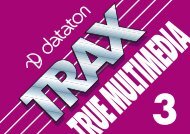Dataton WATCHOUT User's Guide
Dataton WATCHOUT User's Guide
Dataton WATCHOUT User's Guide
You also want an ePaper? Increase the reach of your titles
YUMPU automatically turns print PDFs into web optimized ePapers that Google loves.
playback rendering times related to the native Flash vector format. Instead,<br />
export it as a “QuickTime Video”, using any suitable codec (this feature is<br />
available under MacOS only – use the extra step outlined below under<br />
Windows).<br />
Flash does support transparency (“alpha channel”). However, background<br />
transparency is currently (as of Flash version 4) not preserved when exporting<br />
as a “QuickTime Video” directly. To preserve background transparency,<br />
export it as “QuickTime” (ie, a QuickTime movie containing a Flash track), then<br />
open this using the QuickTime Player and re-export it using the desired codec,<br />
choosing a color depth of “Millions+”. Although this extra step is inconvenient,<br />
it does not reduce the quality of the end result since the first step uses the Flash<br />
vector format, and therefore doesn’t suffer any quality loss due to compression.<br />
Audio<br />
Audio File Formats<br />
Audio is used in <strong>WATCHOUT</strong> in a way that’s very similar to moving images.<br />
Simply bring the sound file into <strong>WATCHOUT</strong> and place its icon on the display<br />
in the Stage window where you want to the sound file to play.<br />
◆ NOTE: Do not place the sound file’s icon so that it straddles multiple displays,<br />
unless you specifically want the same sound file to play from multiple<br />
display computers. Having the sound file play from a computer that isn’t really<br />
used for sound reproduction places an unnecessary processing load on<br />
that computer.<br />
<strong>WATCHOUT</strong> can play any sound file format that QuickTime can handle.<br />
However, the recommended sound file formats are AIFF (a popular sound<br />
format under MacOS) and WAV (common under Windows). There’s usually<br />
no reason to use a compressed sound file format, such as MP3, and the additional<br />
decompression step adds unnecessary load. The size of uncompressed<br />
Chapter 6: Media Files 81




